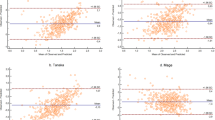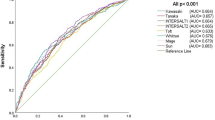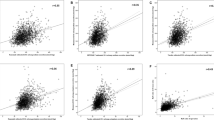Abstract
Background/Objectives:
The assessment of urinary excretion of specific nutrients (e.g. iodine, sodium) is frequently used to monitor a population’s nutrient status. However, when only spot urines are available, always a risk of hydration-status-dependent dilution effects and related misinterpretations exists. The aim of the present study was to establish mean values of 24-h creatinine excretion widely applicable for an appropriate estimation of 24-h excretion rates of analytes from spot urines in adults.
Subjects/Methods:
Twenty-four-hour creatinine excretion from the formerly representative cross-sectional German VERA Study (n=1463, 20–79 years old) was analysed. Linear regression analysis was performed to identify the most important influencing factors of creatinine excretion. In a subsample of the German DONALD Study (n=176, 20–29 years old), the applicability of the 24-h creatinine excretion values of VERA for the estimation of 24-h sodium and iodine excretion from urinary concentration measurements was tested.
Results:
In the VERA Study, mean 24-h creatinine excretion was 15.4 mmol per day in men and 11.1 mmol per day in women, significantly dependent on sex, age, body weight and body mass index. Based on the established 24-h creatinine excretion values, mean 24-h iodine and sodium excretions could be estimated from respective analyte/creatinine concentrations, with average deviations <10% compared with the actual 24-h means.
Conclusions:
The present mean values of 24-h creatinine excretion are suggested as a useful tool to derive realistic hydration-status-independent average 24-h excretion rates from urinary analyte/creatinine ratios. We propose to apply these creatinine reference means routinely in biomarker-based studies aiming at characterizing the nutrient or metabolite status of adult populations by simply measuring metabolite/creatinine ratios in spot urines.
This is a preview of subscription content, access via your institution
Access options
Subscribe to this journal
Receive 12 print issues and online access
$259.00 per year
only $21.58 per issue
Buy this article
- Purchase on Springer Link
- Instant access to full article PDF
Prices may be subject to local taxes which are calculated during checkout



Similar content being viewed by others
References
Hedrick VE, Dietrich AM, Estabrooks PA, Savla J, Serrano E, Davy BM . Dietary biomarkers: advances, limitations and future directions. Nutr J 2012; 11: 109.
Jenab M, Slimani N, Bictash M, Ferrari P, Bingham SA . Biomarkers in nutritional epidemiology: applications, needs and new horizons. Hum Genet 2009; 125: 507–525.
Andersson M, Benoist B, Darnton-Hill I, Delange F (eds). Iodine Deficiency in Europe: A Continuing Public Health Problem.World Health Organization: Geneva, Switzerland, 2007. Available at: http://www.who.int/nutrition/publications/VMNIS_Iodine_deficiency_in_Europe.pdf last accessed 15 July 2015.
Simpson FO, Nye ER, Bolli P, Waal-Manning HJ, Goulding AW, Phelan EL et al. The Milton survey: Part 1, General methods, height, weight and 24-hour excretion of sodium, potassium, calcium, magnesium and creatinine. N Z Med J 1978; 87: 379–382.
Mage DT, Allen RH, Kodali A . Creatinine corrections for estimating children's and adult's pesticide intake doses in equilibrium with urinary pesticide and creatinine concentrations. J Expo Sci Environ Epidemiol 2008; 18: 360–368.
Knudsen N, Christiansen E, Brandt-Christensen M, Nygaard B, Perrild H . Age- and sex-adjusted iodine/creatinine ratio. A new standard in epidemiological surveys? Evaluation of three different estimates of iodine excretion based on casual urine samples and comparison to 24h values. Eur J Clin Nutr 2000; 54: 361–363.
Tanaka T, Okamura T, Miura K, Kadowaki T, Ueshima H, Nakagawa H et al. A simple method to estimate populational 24-h urinary sodium and potassium excretion using a casual urine specimen. J Hum Hypertens 2002; 16: 97–103.
Ohira S, Kirk AB, Dyke JV, Dasgupta PK . Creatinine adjustment of spot urine samples and 24h excretion of iodine, selenium, perchlorate, and thiocyanate. Environ Sci Technol 2008; 42: 9419–9423.
Vought R, London W . Iodine intake and excretion in healthy nonhospitalized subjects. Am J Clin Nutr 1964; 15: 124–132.
Vought R, London W, Lutwalk L, Dublin T . Reliability of estimates of serum inorganic iodine and daily fecal and urinary iodine excretion from single casual specimens. J Clin Endocrinol Metab 1963; 23: 1218–1228.
McLean R, Williams S, Mann J . Monitoring population sodium intake using spot urine samples: validation in a New Zealand population. J Hum Hypertens 2014; 28: 657–662.
Perrine CG, Cogswell ME, Swanson CA, Sullivan KM, Chen T, Carriquiry AL et al. Comparison of population iodine estimates from 24-hour urine and timed-spot urine samples. Thyroid 2014; 24: 748–757.
Rhee M, Kim J, Shin S, Gu N, Nah D, Hong K et al. Estimation of 24-hour urinary sodium excretion using spot urine samples. Nutrients 2014; 6: 2360–2375.
Franke AA, Halm BM, Ashburn LA . Isoflavones in children and adults consuming soy. Arch Biochem Biophys 2008; 476: 161–170.
Koch HM, Becker K, Wittassek M, Seiwert M, Angerer J, Kolossa-Gehring M . Di-n-butylphthalate and butylbenzylphthalate—urinary metabolite levels and estimated daily intakes: pilot study for the German Environmental Survey on children. J Expo Sci Environ Epidemiol 2007; 17: 378–387.
Neubert A, Manz F, Remer T. Iodmonitoring bei Kindern: Iod-Kreatinin-Quotient versus Iodkonzentration im Urin. In: Reiners C, Weinheimer B (Hrsg.). Iod und Schillrüse De Gruyter: Berlin, Germany, New York, NY, USA, 1998.
Remer T, Neubert A, Maser-Gluth C . Anthropometry-based reference values for 24-h urinary creatinine excretion during growth and their use in endocrine and nutritional research. Am J Clin Nutr 2002; 75: 561–569.
Kawasaki T, Itoh K, Uezono K, Sasaki H . A simple method for estimating 24h urinary sodium and potassium excretion from second morning voiding urine specimen in adults. Clin Exp Pharmacol Physiol 1993; 20: 7–14.
Kawasaki T, Ueno M, Uezono K, Kawazoe N, Nakamuta S, Ueda K et al. Average urinary excretion of sodium in 24hours can be estimated from a spot-urine specimen. Jpn Circ J 1982; 46: 948–953.
Cockcroft DW, Gault MH . Prediction of creatinine clearance from serum creatinine. Nephron 1976; 16: 31–41.
Kübler W, Baltzer H, Grimm R, Scheck A, Schneider R. National Food Consumption Survey (NVS) and Cooperative Study: Nutrition Survey and Risk Factor Analysis (VERA). Synopsis and PerspectiveWissenschaftlicher Fachverlag Dr. Fleeck: Niederkleen, Germany, 1997 (VERA-Schriftenreihe Band XIV a).
Speitling A, Hüppe R, Kohlmeier M, Matiaske B, Stelte W, Thefeld W et al Methodological Handbook Nutrition Survey and Risk Factor Analysis. Wissenschaftlicher Fachverlag Dr. Fleeck: Niederkleen, Germany, 1992 (VERA-Schriftenreihe Band Ia).
Heseker H, Adolf T, Eberhardt W, Hartmann S, Herwig A, Kübler W et al Food and Nutrient Intake in Adults in the Federal Republic of Germany. Wissenschaftlicher Fachverlag Dr. Fleeck: Niederkleen, Germany, 1992 (VERA-Schriftenreihe Band III).
Schneider R, Eberhardt W, Heseker H, Moch KJ . The VERA Sample Compared with Census, Microcensus and Other National Studies. Wissenschaftlicher Fachverlag Dr. Fleeck: Niederkleen, Germany, 1992 (VERA-Schriftenreihe Band II).
Buyken AE, Alexy U, Kersting M, Remer T . Die DONALD. Kohorte. Ein aktueller Überblick zu 25 Jahren Forschung im Rahmen der Dortmund Nutritional and Anthropometric Longitudinally Designed Study. Bundesgesundheitsblatt Gesundheitsforschung Gesundheitsschutz 2012; 55: 875–884.
Scheidt-Nave C, Kamtsiuris P, Gößwald A, Hölling H, Lange M, Busch MA et al. German health interview and examination survey for adults (DEGS) - design, objectives and implementation of the first data collection wave. BMC Public Health 2012; 12: 730.
Kampmann J, Siersbaek-Nielsen K, Kristensen M, Hansen JM . Rapid evaluation of creatinine clearance. Acta Med Scand 1974; 196: 517–520.
Kesteloot H, Joossens JV . On the determinants of the creatinine clearance: a population study. J Hum Hypertens 1996; 10: 245–249.
WHO/PAHO Regional Expert Group for Cardiovascular Disease Prevention through Population-wide Dietary Salt Reduction. Protocol for Population Level Sodium Determination in 24-Hour Urine Samples. WHO/PAHO Regional Expert Group for Cardiovascular Disease Prevention through Population-wide Dietary Salt Reduction; 2010. Available at: http://new.paho.org/hq/dmdocuments/2010/pahosaltprotocol.pdf. last accessed 15 July 2015.
Hooft van Huysduynen EJ, Hulshof PJ, van Lee L, Geelen A, Feskens EJ, van 't Veer P et al. Evaluation of using spot urine to replace 24h urine sodium and potassium excretions. Public Health Nutr 2014; 17: 2505–2511.
Zimmermann MB, Andersson M . Assessment of iodine nutrition in populations: past, present, and future. Nutr Rev 2012; 70: 553–570.
Haldimann M, Bochud M, Burnier M, Paccaud F, Dudler V . Prevalence of iodine inadequacy in Switzerland assessed by the estimated average requirement cut-point method in relation to the impact of iodized salt. Public Health Nutr 2015; 18: 1333–1342.
Johner SA, Thamm M, Schmitz R, Remer T . Examination of iodine status in the German population—an example for methodological pitfalls of the current approach of iodine status assessment. Eur J Nutr. e-pub ahead of print 2 January 2015.
Bingham SA, Cummings JH . The use of creatinine output as a check on the completeness of 24-hour urine collections. Hum Nutr Clin Nutr 1985; 39: 343–353.
König F, Andersson M, Hotz K, Aeberli I, Zimmermann MB . Ten repeat collections for urinary iodine from spot samples or 24-hour samples are needed to reliably estimate individual iodine status in women. J Nutr 2011; 141: 2049–2054.
Acknowledgements
We acknowledge the institutions and subjects that initially conducted the VERA Study. Special thanks are directed to Professor W Kübler (†) and Dr K-J Moch for their basic contributions to the NVS and VERA studies and the provision of the VERA public use files. We also thank Prof. H Heseker having participated in the conception of the VERA Study and having made available initial results to the scientific community. The present examination was financially supported by the German Federal Ministry of Food, Agriculture (BMEL) through the Federal Office for Agriculture and Food (BLE), Grant Number 2813HS013. TR and SAJ designed and conducted research, HB and MT provided essential materials, SAJ performed statistical analysis and TR and SAJ wrote paper.
Author information
Authors and Affiliations
Corresponding author
Ethics declarations
Competing interests
The authors declare no conflict of interest.
Additional information
Supplementary Information accompanies this paper on European Journal of Clinical Nutrition website
Supplementary information
Rights and permissions
About this article
Cite this article
Johner, S., Boeing, H., Thamm, M. et al. Urinary 24-h creatinine excretion in adults and its use as a simple tool for the estimation of daily urinary analyte excretion from analyte/creatinine ratios in populations. Eur J Clin Nutr 69, 1336–1343 (2015). https://doi.org/10.1038/ejcn.2015.121
Received:
Revised:
Accepted:
Published:
Issue Date:
DOI: https://doi.org/10.1038/ejcn.2015.121
This article is cited by
-
A systematic review: on the mercaptoacid metabolites of acrylamide, N-acetyl-S-(2-carbamoylethyl)-L-cysteine
Environmental Science and Pollution Research (2023)
-
Urinary Excretion of Silicon in Men, Non-pregnant Women, and Pregnant Women: a Cross-sectional Study
Biological Trace Element Research (2020)
-
Contribution of iodized salt to total iodine and total salt intake in Germany
European Journal of Nutrition (2020)
-
A systematic review and meta-analysis of 24-h urinary output of children and adolescents: impact on the assessment of iodine status using urinary biomarkers
European Journal of Nutrition (2020)
-
Elevated urinary Na/K ratio among Lebanese elementary school children is attributable to low K intake
European Journal of Nutrition (2017)



